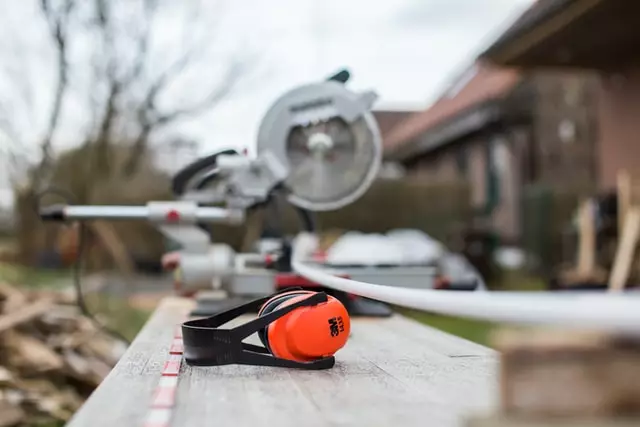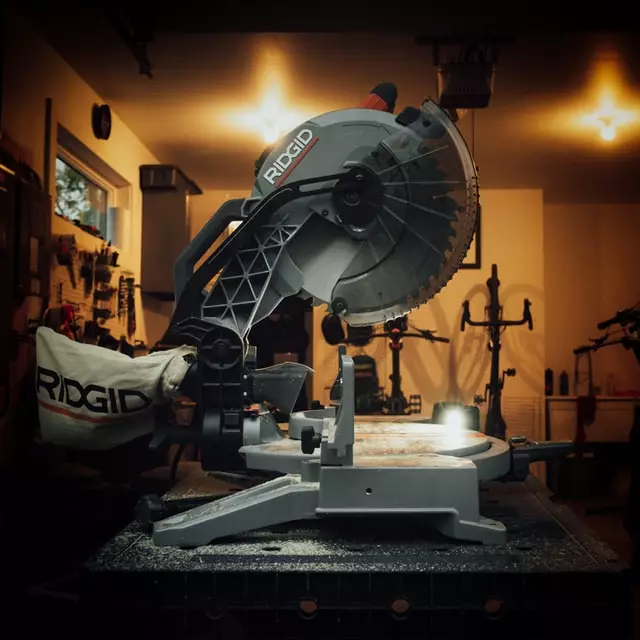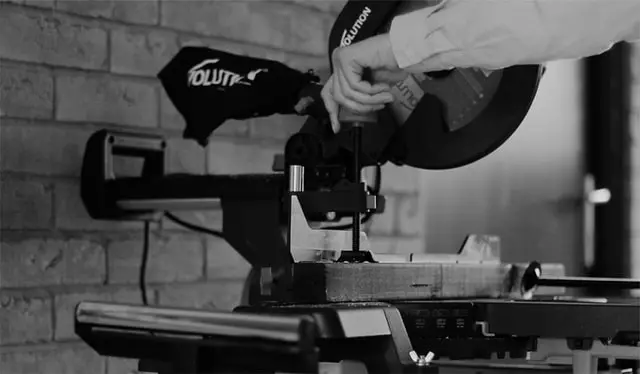Yes, a beginner can use a miter saw. A miter saw is one of the most straightforward tools for beginners to learn and allows you to make many things while learning how to use a miter saw correctly. It gives you clean cuts every time with angled cuts between 45 degrees and 90 degrees.
The users must remain safe and pick the right miter saw that suits their needs. If you are a homeowner, get a miter saw suitable for the versatility of chores.

What is a miter saw?
A miter saw is a tool that allows you to make cuts at various angles. It has a saw blade mounted on the arm that makes pivots from both the right and left sides for angled cuts. The saw tool is for frames and window casings.
The miter saw has three variations: the dual compound and the sliding compound. Compound miter saw that pivots tilt in a single direction for bevel cuts and make compound cuts in one pass. The first miter saw tilts one-way, whereas the Dual compound miter saws tilt from left and right.
The Sliding compound miter saws are versatile. They come with a sliding feature that moves the blade forward and backward. That feature increases the length of the cut. That allows it to make quicker bevels at many angles.
If you are looking for a miter saw with more cutting power, you should consider higher Amps. Precise cuts produce flawless surfaces. More positive stops are required to avoid time-consuming project set-up cuts. Using saws with thumb-activated stops gives quick adjustments.

There are different models to consider when buying a miter saw. Mount the smaller unit on a workbench, and you can have a bigger one that does not need transportation to and from work. Multiple sizes of blades suit the needs of different applications.
What is important is buying a blade compatible with your miter saw. That way, you avoid blaming your miter saw for a technical fault. Ensure the extension cord is the right one for the miter saw.
Different types of miter saws
Sliding Miter Saw
A sliding miter saw is a miter saw that adds rails to the saw blade. It allows it to slide from front to back across the wood and gives you a greater depth of cut than the same-size miter saw without rails. Sliding miter saws make a compound cut and can be the best model for cutting deeper material like 1×12 or 2×12 lumber. For a more compact saw, it is not the ideal model.
Compound Miter Saw
A compound miter saw is for bevel cuts in addition to its mitering ability. It works with crown molding or other trim installed on a wall. Mitering occurs when you rotate the saw blade around a base, and the base holds a scale that tells you the miter angle in degrees. When you plan to cut wood, you might consider having one.

Compound Sliding Miter Saw
The compound sliding miter saw is a hybrid saw that uses rails to increase the cross-cut capacity. It adds a left bevel to enable compound cuts, and you get the flexibility of a compound miter saw with the increased depth of cut afforded by the slide. You might go for it if you need to cut deeper material like 1×12 or 2×12 lumber. However, it might be bad if you want a more compact saw for greater portability.
Dual Compound Sliding Miter Saw
A dual compound sliding miter saw features a miter table, sliding rails, and beveling that goes left and right. Flipping your material around is unnecessary to make the opposite compound cut. That saves time and frustration. If you prefer making your crown and base molding cuts flat, this saw saves you time. It is ideal for cutting longer pieces of material.
Miter saw safety

Miter saws can be dangerous if used improperly, so following safety guidelines is important. Here are some safety tips to keep in mind:
- Wear safety glasses or a face shield to protect your eyes from flying debris.
- Use dust extraction and a respirator to avoid inhaling sawdust.
- Wear appropriate hearing protection to prevent hearing damage.
- If necessary, wear protective footwear to protect your feet.
- Attach the saw to a workbench or other rigid frame and guide the saw at waist height to ensure stability.
- Before sawing, ensure the power is off and the machine is not moving.
- Hold the trigger and handle with one hand and use the other hand to hold the material against the fence.
- Keep hands out of the path of the blade to avoid injury.
- Leave guards in place to prevent accidents.
- Remove adjusting wrenches and wrenches to prevent them from getting caught in the blade.
- Make sure the blade rotates in the correct direction to prevent accidents.
- Secure and clean the blade and arbor regularly.
- Keep the blade firm, sharp, and adjusted to cut easily.
- Cut only one workpiece at a time to avoid accidents.
- Allow the motor to reach full speed before cutting to avoid damage to the blade or motor.
- Wait until the saw stops moving before removing the workpiece to avoid accidents.
- Follow instructions for lubricating and changing accessories to ensure safe operation.
- Keep the work area clean to prevent slips and falls.
- Make sure the saw switch is in the OFF position before plugging in.
- Unplug the saw before servicing and when not in use to prevent accidents.
- Inspect the saw for damage, repair or replace damaged parts before using the saw.
- To prevent overheating, keep the motor air slots clean and free of dust and French fries.
- Use accessories appropriate for the saw and the job to ensure safe operation.
Best beginner miter saw
A miter saw is a versatile tool that easily cuts wood and trims lumber down to size. The Craftsman CMCS714M1 is an ideal miter saw for portability as it’s incredibly lightweight. You are allowed to add accessories of your choice. That comes for an extra price.

Like a sliding miter saw, the CMCS714M1 creates cross-cuts at different degrees. The brand also adds more cutting capacity to this model to improve its functions. LED cut line positioning system ensures precise cuts.
How do you use a miter saw for beginners?
Using a miter saw for beginners can be intimidating, but it doesn’t have to be. Here are the basic steps you should follow:
- Briefly check to make sure the saw is cutting straight. This is important to ensure accurate cuts. To do this, make a test cut on scrap wood and check that the cut is straight.
- Check the saw blade and adjust it if necessary. Make sure the saw blade is clean, sharp, and properly attached to the saw. If necessary, adjust the blade to be perpendicular to the table.
- Measure the board. Use a tape measure to measure the length of the board to be cut.
- Place the board on the miter saw so the back edge is against the fence. The fence is the vertical part of the saw that forms a straight edge to guide the workpiece.
- Hold the board firmly in position. Use clamps or your hands to hold the board in place and prevent it from moving during the cut.
- Cutting. Lower the blade onto the board and cut by pulling it down and pushing it through the wood.
Remember to always follow safety guidelines when using a miter saw, such as wearing eye and hearing protection and keeping your hands away from the saw blade. Practice on scraps of wood before cutting your actual project materials. With time and a little practice, you’ll become more comfortable with the miter saw.
Parts of a miter saw
- A typical miter saw consists of several parts:
- Clamp bolt
- Brush
- Blade adapter ring
- Kerf plate
- Blade
- Fence
- Dust bag
- These parts work together to help you make precise and accurate cuts in your woodworking projects.
- The clamp bolt is used to secure your workpiece in place.
- The brush helps to remove debris from the blade.
- The blade adapter ring is used to attach the blade to the saw.
- The kerf plate helps to guide the blade during cuts.
- The fence provides a straight edge to guide your workpiece.
- The dust bag collects sawdust to keep your workspace clean.
How do you use a miter saw to cut angles?
Using a miter saw to cut angles can be tricky, but with the right approach, it’s easy to make accurate and precise cuts. Here are the steps you should follow:
- Determine the angle you need to cut: Before you start cutting, you need to know the exact angle you need to cut. Use a protractor or angle finder to measure the angle.
- Set the miter saw angle: Once you have determined the angle, set the miter saw accordingly. To do this, release the miter lock and rotate the saw blade until it matches the desired angle.
- Set up a jig: To ensure the material stays in place while cutting, it’s a good idea to use a jig. The jig is your new fence and helps keep the material secure during the cut.
- Cut the material: once the saw blade and template are properly set, you can start cutting the material. Hold the material securely against the fixture and lower the saw blade to cut.
- Check the angle: Once you have cut, ensure the angle is accurate. Make necessary adjustments and repeat the process until you achieve the desired result.
What kind of table do I need for a miter saw?
When choosing a table for your miter saw, there are several factors to consider. First and foremost, you should consider the size of your work area and the size of the materials you plan to cut.
A good table for a miter saw should be sturdy, level, and have an adequate support surface for the material you’re cutting. It’s also important that the table has the right height to operate the saw comfortably.
If you want to cut long pieces, you may need additional supports or rollers to keep the material stable and prevent it from sagging or tipping. It’s also a good idea to choose a table with adjustable stops or clamps that allow you to securely hold the material in place while you cut.
Do you have to mount a miter saw?
Although it is unnecessary to mount a miter saw, it is recommended to be used on a stable and level surface to ensure accuracy and safety during operation. Using a miter saw on an unstable platform can increase the risk of accidents or injuries. Therefore, it is advisable to place the saw on a workbench or table to ensure stability and prevent the saw from moving during use.
It is worth noting that miter saws are designed to be portable and easily transported to job sites or other locations where they are needed. Even if you do not need to mount a miter saw, it’s important to use it in a stable and safe place to make the most of its capabilities.
What projects can you use a miter saw for
A miter saw is a versatile tool that can be used for a wide range of projects, from simple DIY jobs to more complex woodworking projects. Here are some examples of projects that can be done with a miter saw:
- Building a wooden planter
- Making custom picture frames
- Making a serving tray
- Cutting simple cabinets
- Building a bookcase or media console
- Attaching baseboards or decorative trim
- Crafting a wooden toy or puzzle
- Constructing a birdhouse or doghouse
- Making a wooden bench or chair
These are just a few examples of the many projects that can be done with a miter saw. With its ability to make accurate and precise cuts at various angles, a miter saw is a valuable tool for any woodworking enthusiast or DIYer.
Can a miter saw be used on the ground?
It is not recommended to use a miter saw on the floor as this poses a safety hazard and may increase the likelihood of back injury from the weight of the saw and the wood. Instead, it is recommended that you secure the miter saw to a sturdy workbench or table with screws or clamps to ensure stability and safety during use. This way, you will have a safe and stable work surface and avoid accidents or injuries while working with the saw.
- Grain and Sheen: Teak Oil versus Danish Oil Uncovered - January 10, 2024
- The Cherry on Top: Crafting the Perfect Cutting Board - January 9, 2024
- Polyurethane Water-Based vs Oil-Based: Choosing the Right Finish - January 8, 2024